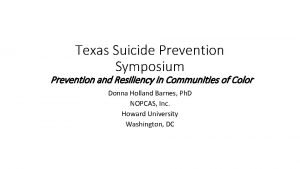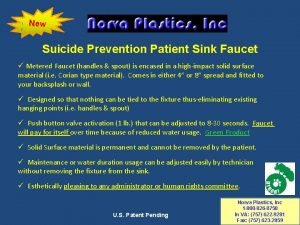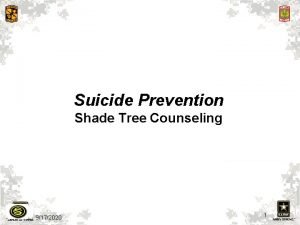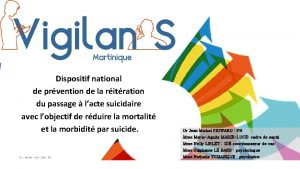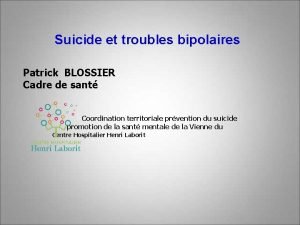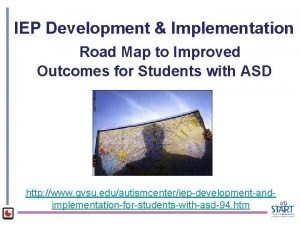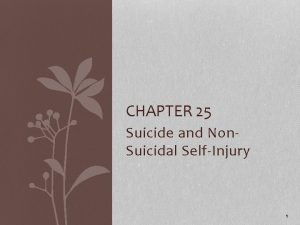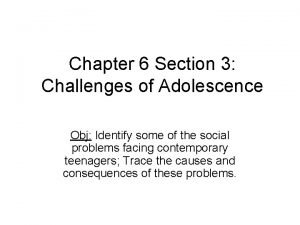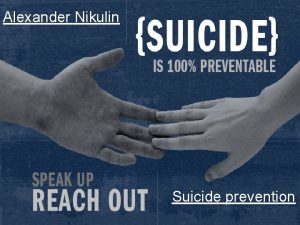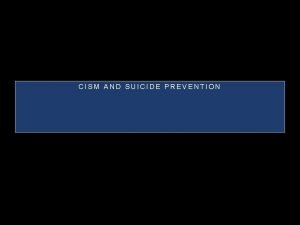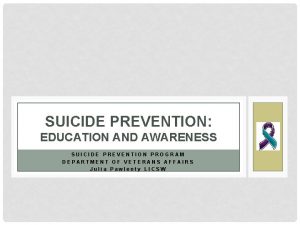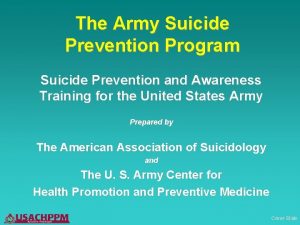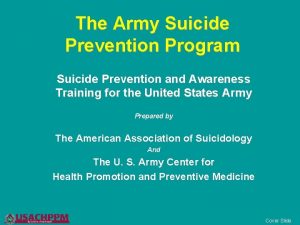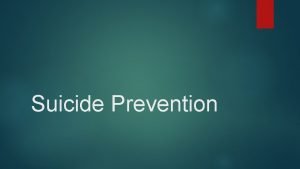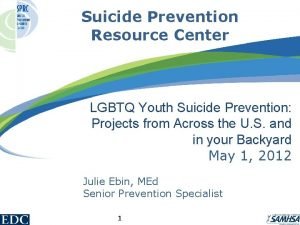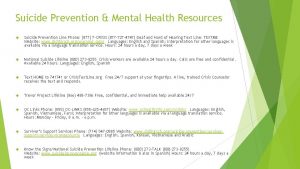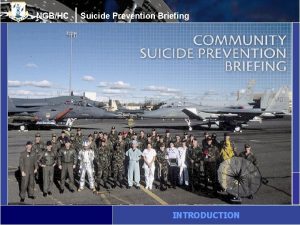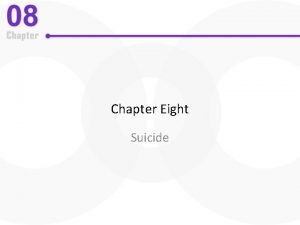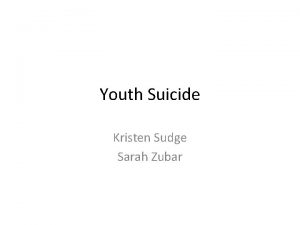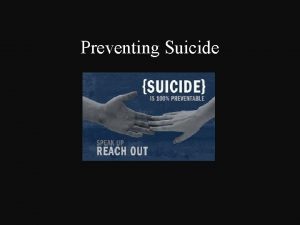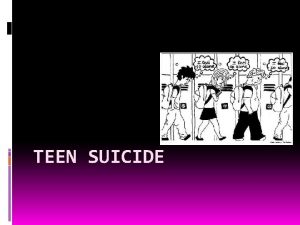THE DEVELOPMENT AND IMPLEMENTATION OF A SUICIDE PREVENTION




















- Slides: 20

THE DEVELOPMENT AND IMPLEMENTATION OF A SUICIDE PREVENTION INITIATIVE: THE TRAFFIC LIGHT SAFETY PLAN 1 Presented by Dr Elizabeth Preston and Edward Zeballos Older People’s Mental Health Service (OPMH), NSW Health

THE DEVELOPMENT AND IMPLEMENTATION OF A SUICIDE PREVENTION INITIATIVE: THE TRAFFIC LIGHT SAFETY PLAN Project Leaders: Dr Elizabeth Preston – Clinical Psychologist, OPMH community Edward Zeballos - Clinical Nurse Consultant, OPMH Acute Inpatient Unit Dr Dev Lakshmanan – Psychiatrist, OPMH Acting Director Jeni Martin – Clinical Psychologist, OPMH; Acute Inpatient Unit James Bradbury - Clinical Nurse Consultant, OPMH Community 2

SUICIDE PREVENTION In Australia, 3128 people died from intentional self-harm in 2017. Research indicates these rates continue to rise. The Australian death rate for 2017 was 12. 6 deaths per 100, 000 persons. Approx. 46 th in the world On 26/09/2018 the government allocated $36 m to suicide prevention projects Lifeline received close to 1 million calls in 2018 and on average helped 115 people make a safety plan each day 3

4

RATIONALE / BACKGROUND Consumers discharged from mental health inpatient units have a markedly increased risk for suicide compared to other consumers with mental health issues An Australian meta-analysis of over 100 studies concluded: Suicide prevention should commence during the inpatient admission Suicide prevention strategies ought to continue once the person is discharged 5

6

AIM OF CURRENT RESEARCH PROJECT To develop a formalised procedure and format for the design and implementation of consumer safety plans as part of suicide prevention strategies To give consumers and family opportunity to ‘raise their voice’ about suicide and the design of their safety plans The project is initially targeting all consumers discharged from the OPMH Acute Inpatient Unit, Wollongong Hospital View to expand to other mental health inpatient units following 7 evaluation

THE TRAFFIC LIGHT APPROACH The ‘traffic light’ approach is an easy to understand colour coded system to: identify levels of suicidality communicate levels of distress choose appropriate strategies/responses 8

FORMAT The ‘red’ category relates to high levels of suicide tendencies, recommending: contacting mental health helpline immediately telling a family member or friend presenting to the emergency department calling emergency services (if required) The ‘amber’ category relates to moderate levels suicide tendencies, recommending: contacting the community mental health team for support individualised distress tolerance and distraction strategies The ‘green’ category relates to low levels of suicide tendencies, 9 recommending: individualised strategies aimed at maintaining wellbeing

OLDER PEOPLE'S MENTAL HEALTH SERVICE Name, Date TRAFFIC LIGHT SAFETY PLAN WHEN TO USE THIS PLAN This plan should be used if you are feeling very upset (i. e. , thoughts of suicide or self harm, or feeling overwhelmed, panicky, anxious, or hopeless). It provides ideas for helping with these feelings, because sometimes it is hard to think clearly when you are feeling very upset. You may wish to talk about this plan with your family so that they can encourage you to use this plan if needed. SAFETY WARNING It is strongly recommended that you dispose of 10 old/unused medications to your pharmacy. For your safety, please remove items at home that

MY TRAFFIC LIGHT SAFETY PLAN WHAT’S HAPPENING? • VERY UPSET QUITE UPSET A LITTLE UPSET • • • Strong thoughtsabout Suicide Strong thoughts about Self Harm Conflict with Family Feeling very depressed • • • WHAT TO DO? Making a Plan to takemy • Life Making Plan to hurt myself • Can’t sit still • Crying Feeling very bad • Cannot cope WHAT’S HAPPENING? • • • Thoughts about. Suicide Thoughts about Self Harm Thinkingthat ______ Worry about _____ Feeling guilty about _____ • • Lying down a lot No energy No enjoyment in anything Don’t want to do anything WHAT TO DO? • • WHAT’S HAPPENING? • • • Short-lived thoughts about Suicide Short-livedthoughts about Self Harm A few worried thoughts • • Not doingmuch activity Not feeling like going out Feeling a little nervous Feeling a little down Tell one of the Staff (if in facility) Tell Support Person _____ Call the Mental Health Helpline 1800 011 511 Call 000 if you need Emergency Help Practice the Amber Ideas for how to cope Call your Case Manager _____ Ph: 4220 7900 during office hours Mon-Fri 8. 30 am-5 pm Talk to Support Person _____ WHAT TO DO? • • Use the Green ideas for How to cope Talk to Support Person ______ 11

HOW TO COPE IF I AM QUITE UPSET Comfort Yourself Make a coffee & sit outside in the sun Read A good book Relaxation • Do your Breathing – 3 counts in… hold 3 counts… breathe out 3 counts Talk to Support Person/Care Staff Be open about your thoughts and feelings Have a lie down on your bed/lounge Relax your body and get some comfort Distraction • QUITE UPSET Focus on something else Plan a holiday Think of happy times Watch some TV Make a cuppa 12

HOW TO COPE IF I AM A LITTLE UPSET • Still keep your plans for the day (e. g. , coffee with sister, walking the dog) • Do a small chore (e. g. , brush the dog, put dishes away) • Remember to think positively • Keep yourself occupied with activities (e. g. , find-a-word, knitting, paint nails, baking) A LITTLE UPSET • Remember your Strengths and that you are a strong person with a strong mind. 13

PARTICIPATING SITES This project will be implemented across OPMH settings: OPMH Acute Inpatient Unit OPMH Community Team, Illawarra OPMH Community Team, Shoalhaven 14

STUDY DESIGN AND OUTLINE This project based on an Action Research approach This project has 4 phases: Planning 2. Action 3. Observation 4. Reflection 1. 15

PHASE 1: PLANNING Regular meetings with project leaders since December 2018, initially focusing on developing draft safety plans Subsequently the development and implementation of safety plans with appropriate consumers The planning stage will also involve collaboration and feedback from the Consumer Peer Workforce and Official Visitors Development of a family focused safety plan 16

PROCEDURE 17

PRELIMINARY FEEDBACK “Helps me know when to go to the hospital and when to manage my feelings myself” “I love this plan, I’ve had mental health issues for decades but I’ve never seen something like this” Helps family members feel more confident in ways to support their loved one Helps transfer of care from inpatient unit to community team Facilitates care planning by ED and Mental Health Helpline staff 18

IF SUCCESSFUL HOW CAN THIS PROJECT BE INTRODUCED AREA WIDE? AIM Plan 1. Define the Change 2. Build Agent Capacity 3. Assess the Climate 4. Generate Sponsorship 5. Change Approach 6. Target Readiness 7. 8. 9. 10. 11. Build communicating plan Develop reinforcement strategy Create cultural fit Implementation Risk Forecast Monitoring and Evaluation 19

REFERENCES 20
 Primary prevention secondary prevention tertiary prevention
Primary prevention secondary prevention tertiary prevention Mad acronym suicide prevention
Mad acronym suicide prevention Chapter 5 glencoe health
Chapter 5 glencoe health Suicide chain teach
Suicide chain teach Texas suicide prevention symposium
Texas suicide prevention symposium Mental health faucets
Mental health faucets Shadetree army
Shadetree army Prévention du suicide
Prévention du suicide Suicide prevention month quotes
Suicide prevention month quotes Army suicide prevention training
Army suicide prevention training Vivien blossier
Vivien blossier Iep development and implementation
Iep development and implementation The sad persons scale
The sad persons scale 8 stages of system development life cycle
8 stages of system development life cycle Sara calixto suicide girl
Sara calixto suicide girl Citadel counseling center
Citadel counseling center Youth suicide research consortium
Youth suicide research consortium Bill nye the science guy life cycles
Bill nye the science guy life cycles Suicide icd 10
Suicide icd 10 Egoistic suicide
Egoistic suicide Suicide cuts across all social categories
Suicide cuts across all social categories




